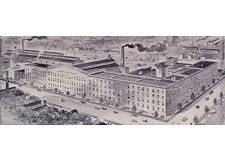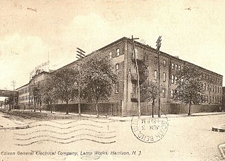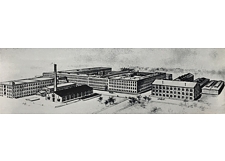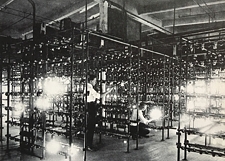|
Harrison / West Newark Lamp Works |
|
The Harrison lamp works, also known as West Newark lamp works, was one of the earliest large-scale lamp factories in the world. It was founded in 1882 as Edison's principal production site for the manufacture of carbon filament lamps, following the explosive rate of growth of his lamp which quickly outgrew the small facilities at the original Menlo Park site. Harrison ultimately became the principal lamp works of General Electric, until the late 1920s when production requirements once again outstripped the capabilities of this site and lampmaking was divested to several other factories around the USA.
|

Harrison / West Newark Edison Lamp Works |
| Address |
Bergen Street & South 5th Avenue, Harrison, West Newark, NJ, U.S.A. |
| Location |
40.7436°E, -74.1453°N |
| Opened |
1882 |
| Closed |
Lampmaking ceased in 1929. Thereafter produced electronic tubes until 1976. |
| Products |
Carbon filament lamps, tungsten filament lamps, glass bulbs. |
Early Edison Commercial Activities
Edison's commercial activities related to lamps began on 17th October 1878 with the formation of the Edison Electric Light Company, which was founded to hold the patents and to provide the capital necessary to fund further lamp developments. There was stiff competition from several other inventors all striving to be first to create the incandescent lamp, and Edison was urged to speed up by his friend Grosvenor P. Lowrey, a leading New York lawyer. Edison considered that he did not have sufficient capital to fund the operation alone, and was introduced to several of Lowrey's clients, including J.P. Morgan, without doubt the most influential banker of his generation. The new company was organised with a capital of $ 300,000.
Following the successful invention of Edison's first lamp at the end of 1879, it was clear that factories would have to be established to manufacture the lamps and associated equipment. The directors of the Edison Electric Light Company were unwilling to support this venture, considering that Edison should focus on inventions and patents rather than production. Edison disagreed profoundly, and set about founding his own manufacturing companies. Accordingly The Edison Lamp Company was organised with Edison himself holding 80% interest. Its sole purpose was to manufacture the Edison lamps on a commercial scale, under the patents owned by the Edison Electric Light Company, for exclusive supply to the latter. Edison believed that it would be unwise to buy the other equipment needed for lighting installations from existing manufacturers, and organised three other manufacturing companies to produce dynamos, underground conduits, cables, switchgear, meters and indeed the complete package of equipment necessary for the generation and distribution of electricity and its use for lighting. These were the Edison Machine Works, The Edison Tube Company, and The Edison Shafting Company (in 1883 they were all merged into the Edison Machine Works at Schenectady, NY). The only part he left in the control of others was the business of making the more decorative items such as lighting fixtures, sockets, switches and so on. These were produced by Sigmund Bergmann & Company - Bergmann having been a former Edison employee who set up his own business in 1880, becoming a particularly successful manufacturer and ultimately establishing a German subsidiary that was later to become a founding part of OSRAM.
The first factory of the Edison Lamp Company was established in a wooden clapboard building about half a mile away from the Menlo Park labs, which had formerly manufactured Edison's electric pen. It had lain derelict for some years, until the summer of 1880 when Edison sent his carpenters to renovate the building, and his chief mathematician, Francis R. Upton set up the equipment needed for lampmaking. It went into production in November 1880.
Edison had already fixed the end customer's buying price for his lamps such that the new factory would have to sell to the parent company at 40 cents each - even though at the time he had little idea how much the real production cost would be. It turned out to be a financial catastrophe, with the lamps in fact costing $ 1.10 to produce! It was clear that his manufacturing venture would not be profitable, but far from acknowledging the decision of his directors not to invest in that fiasco, Edison saw it as a challenge to reduce his production costs by developing new mass-production techniques. And he succeeded. Not without the initial disgruntlement of some of his colleagues however. His principal glassblower, Ludwig Boehm complained bitterly when Edison hired William Holzer to investigate cheaper methods of blowing bulbs into steel moulds, and Boehm shuddered to witness 'the noble art of glassblowing' degenerataing into a crass factory operation.
The average cost to produce a 16-candlepower lamp during 1881 plummeted to 70 cents, then to 50 cents in 1882, and the operation finally became profitable when a level of 37 cents was reached in 1883. Despite the meagre 3 cent profit, the volume of lamps sold in 1883 was sufficient to wipe out all of the earlier losses. Production costs declined further to just 22 cents, and combined with skyrocketing volumes this transformed the Edison Lamp Company into a tremendous cash cow. For a period Edison detached himself from the established financial practice of offering an annual dividend to his shareholders by impressively offering a weekly payout every Saturday night, in a snub directed at the bankers who had previously refused to finance his lampmaking ambitions. Naturally it caught the instantaneous attention of Wall Street - and Edison sold out his lamp works for the monstrous sum of ,085,000.
Despite the financial success of these enterprises Edison gradually withdrew from active participation in his manufacturing companies during the period 1884 to 1889, to devote his attention to the core business of creating other new inventions at the Menlo Park laboratories. In 1886 all of the manufacturing subsidiaries were united when the Edison Lamp Company was merged with the Edison Machine Works and also took control of The Bergmann Company, to form The Edison United Manufacturing Company. In 1889 this was itself swallowed up together with the parent Edison Electric Light Company, the Canadian Edison Manufacturing Company and some smaller competitors to form the Edison General Electric Company, with a capital of $ 12 million. The business was controlled primarily by the influential New York financier Henry Villard, and the German electrical giant Werner Siemens, who died only three years later.
|
Start of Operations at Harrison
Demand for the Edison lamps grew rapidly, and with it the requirement for suitable labour. In the small town of Menlo Park it was proving difficult to procure the services of sufficient boys and girls, for performing the lighter manufacturing tasks. That necessitated a move towards the nearby city of Newark, NJ, and in the summer of 1881 Edison purchased the site at Harrison on the corner of Bergen Street and South 5th Street. The buildings there had formerly been occupied by the Peters Manufacturing Company, makers of oilcloth. It occupied an entire block and consisted of three four-storey buildings and the ruins of another, plus a boiler house, office, stables, dwelling house and ancillary sheds. Edison procured the works at a low price because it had been damaged by fire and required renovation. The floorspace was about ten times greater than that of the Menlo Park factory, and the vacant land on the site offered considerable potential for future expansion. Indeed, Harrison was to become the principal home of Edison lamps during the following five decades.
The Menlo Park works was closed down on 1st April 1882, with about 50,000 lamps being held in stock at the time. Production was resumed at Harrison on 1st June 1882, and about 150 staff produced a daily output of approximately 1200 lamps. As noted above the initial production was not profitable, and the factory's engineers were responsible for the development of nearly all of the techniques of mechanised production on which the present lamp industry still continues to rely. These efforts were led by John W. Howell, a young electrical engineer who devised countless machines and processes for the low cost and automatic production of electric lamps, especially after the transition to General Electric.
|
Transition to General Electric
In 1892 there were two principal electrical manufacturers in the USA - the Edison General Electric Company and the Thomson-Houston Electric Company. Westinghouse was also a sizeable competitor. All were large scale manufacturers of lamps, but their dominance was being challenged by a number of small producers eager to enter the lucrative lamp business. Edison had of course patented his lamp but was slow to begin defending his rights through the courts - partly because his technical lead was at first sufficiently advanced that competitive lamps lagged behind in their performance, but also because of the great complexity of proving the often minimal differences of competitive designs. However the enormous profits being earned in lamps began to attract many newcomers, and in 1885 these became more aggressive and challenged the validity of the basic Edison US Patent 223,898. A long and painful lawsuit ensued, with the hearing beginning only in 1889. After an appeal, it was ultimately settled in the Autumn of 1892 when the judge ruled in favour of the Edison patent. However the patent was due to expire in 1894, and had the smaller companies survived until then, they would have presented a formidable threat to the established manufacturers.
Because of the importance of the basic lamp patent to the profitability of both Edison General Electric and Thomson-Houston, the two companies decided to merge, producing one giant electrical company with improved economies of scale and which would be able to better stamp out the small competitors. Although both companies were engaged in similar businesses, they complemented each other well. Edison's manufacturing operations, although larger than T-H, had been left to fend for themselves to a certain extent as Edison re-focussed his interests on other inventions and T-H often had the upper hand in terms of technical excellence. For instance, Harrison continued to blow its glass bulbs by hand without use of moulds until as late as 1892, whereas other factories had changed years beforehand. It was not until 1894 that Harrison abandoned the original vegetable fibre bamboo filaments of Edison, whereas competitors quickly adopted the superior squirted filaments of artificial silk developed by Sir Joseph Swan, and improved by Leigh S. Powell in 1888. Even on the power generation and distribution side, Edison had persisted in promoting his DC system, whereas T-H was rapidly gaining ground with its more efficient AC system. Conversely, T-H was less successful in sales and distribution, while the Edison approach of selling its goods via the Central Generating Stations was supremely profitable. It became clear to both companies that to combine their relative strengths would generate a new superpower in the electrical industry, against which few others could compete.
The result was the formation of the General Electric Company of America (GE), announced on 15th April 1892 and formally launched on 1st June. The dynamic founder of Thomson-Houston, Charles Coffin, became the first president and he was aided greatly in securing investment to grow the business by the all-powerful and ruthless financier J.P. Morgan of New York. The stature of Morgan at the time is aptly illustrated by a description of a railroad king in 'The Robber Barons' by Josephson - "He feared neither God nor Morgan". The formidable new company employed 10,000 staff, enjoyed $ 35 million of capital and generated monstrous sales of US $ 21 million. By far the majority of its profits were earned from lamps.
Following the confirmation of validity of the basic Edison patent, GE wasted no time in taking legal action against the smaller infringers. No licenses were offered, in every case they aimed to shut down the competitors' factories, put them out of business, and establish the complete monopoly to which the directors of GE believed they were entitled. GE's share of the American lamp business rose quickly from less than 50% to about 75-80%. The only significant competitor that evaded destruction was Westinghouse, which devised a non-infringing lamp. Although rather less effective and more expensive, it was sufficient to tide the company over until the Edison patent expired. Similar scenes were played out internationally, as GE continued with forceful innovations to further improve its lamps, and took out countless additional patents that would continue to dominate the majority of surviving lampmakers around the globe. The inordinate profits that GE gained from its near-monopoly of the lamp business allowed it to pursue with success a similar strategy in many other electrical avenues, to become the undisputed global leader of the lighting and electrical industries.
|
Competition between the Edison and Thomson-Houston Lampworks'
At the time of the creation of GE, there were two lamp factories : the Edison Works at Harrison, and Thomson-Houston also had its own operations at Lynn, Massachusetts. It was recognised that to attain the maximum strength, one of them should be eliminated and all production concentrated at a single site. The decision was entrusted to Edwin W. Rice Jr., the first technical director of GE. He was a former Thomson-Houston man and had a long association with that company, having been the star pupil of Professor Thomson during the latter's earlier career a school teacher. The two later worked side by side in the laboratories at Lynn, and by the age of just 22 Rice had taken over as general superintendent of the Lynn plant. The Edison men considered it a done deal that Lynn would of course be favoured - but Rice announced a competition. The factory producing the best lamps would stay open, and the two plants would test each other's products and judge the matter for themselves.
At the time the competition was announced, there can be no doubt that the Lynn lamps were greatly superior. Thomson-Houston lamps benefited from the 'flashing' process that had been developed by William E. Sawyer in 1880, who had operated the Sawyer-Mann Incandescent Lamp Company which was absorbed by T-H at the debut of its lampmaking business. Flashing consisted of lighting the raw carbon filaments in gasoline vapour prior to being mounted in the bulbs. This evened out the filament cross-section due to the fact that any thin regions would naturally burn hotter, and lead to decomposition of the hydrocarbon vapour in that vicinity, depositing extra carbon onto the filament. The result was a more consistent filament that could be burned hotter and with greater luminous efficacy for a given lifetime. Even Edison himself admitted the superiority of the Thomson-Houston lamps - at that time having withdrawn almost completely from the lampmaking business.
Sawyer had patented the flashing process, and as the successor to his business Thomson-Houston naturally took full advantage of this ingenious process. However upon the formation of General Electric, the former Edison plant naturally gained rights to use the patents formerly controlled by T-H - and vice-versa. John W. Howell, an electrical engineer at Harrison who would later become famous for his conception of countless automatic lampmaking processes on which the world still relies, developed a new machine for the automatic treatment of filaments. This accelerated the flashing process and controlled it better than the manual operators at Lynn could achieve. The result was quickly applied to the Edison production, and propelled the Harrison lamps into the lead.
Consequently Harrison was kept open and the Lynn lampmaking activities came to a close (although Lynn was a vast site, which of course continued with its other electrical products). This kind of vicious internal competition was a model greatly favoured by GE's president Coffin, to push the company's engineers to achieve the very best. It was a technique that he applied repeatedly, even so far as to stimulate external competitors such that his own engineers would be forced to react by bettering their own company in order to secure ultimate long-term leadership for GE.
|
Closure
Over the years the lampworks at Harrison grew to enormous proportions. Numerous building additions and expansions were made, as can be seen in the images below. At the time of the GE merger in 1892 and after absorbing Lynn, it had expanded to a total of 24 buildings covering a floorspace of 153,956 square feet, and employed 1044 staff. By 1912 this figure had risen to 4000 employees.
Other satellite factories of Harrison were established around the USA to cater for the growing demand. These operated under the name of the Edison Lamp Works of General Electric and included factories at Fort Wayne in 1906, Newark in 1907, East Boston in 1913, Oakland in 1912 and Scranton some time before 1924. In addition, General Electric had been required under the anti-trust laws of 1911 to formally integrate its National Lamp Works division - a collection of independent manufacturers that operated under the complete financial control of GE but under the guise that the National Lamp Works' companies were actually competitors of the Edison Lamp Works'. GE had thereby been able to mop up virtually all of the smaller competitors except Westinghouse, but avoid the public perception that it has in fact attained a virtual monopoly over the electric lamp business. As such, by the middle of the 1920s GE was operating a large number of lamp factories across the USA.
Despite its leading position at the time of the foundation of the lamp business, the production volumes had greatly outstripped the capabilities of Harrison and it came under increasing competition from other more efficient plants elsewhere within GE. Harrison was ultimately closed down in 1929, having served as the principal home of Edison lamps for almost five decades.
However the buildings did not have the chance to stay idle for long. In 1932 they became home to another of GE's fledgling industries - known as the Radiophone Corporation of America. RCA had begun life in the Cuyahoga Lamp Plant of GE's NELA Park in Cleveland, Ohio, and moved again to the site of the Euclid Glass Works before finally settling down in New Jersey. Harrison was the base of RCA and GE's electronic tube division until it closed down in 1976, following the rapid decline of valves and vacuum tubes due to new semiconductor innovations. The factory buildings have since been demolished and the sprawling Harrison site is now home to a shopping mall.
|
Photographs
|
 |
|
 |
|
 |
|
 |
| Edison Lamp Company |
|
1892 Edison General Electric |
|
Post-1982 General Electric |
|
Post-1982 General Electric |
|
 |
|
 |
|
 |
|
 |
| End view of works |
|
Tungsten lamp finishing |
|
Life Test Department |
|
Life Test Department |
Examples of Harrison Lamps
|
 |
|
 |
|
 |
|
 |
|
 |
|
|
| Edison Carbon 1884 |
|
Edison Carbon New |
|
GE Sintered Tungsten |
|
A-line Inside Frosted |
|
Carbon Stereopticon |
|
|
| 1 |
Menlo Park Reminiscences, F. Jehl, publ. The Edison Institute 1938, pp.807, 814-816.
|
| 2 |
Lamps for a Brighter America, P.W. Keating, publ. McGraw-Hill Book Company 1954, pp. 20, 34, 43-44.
|
| 3 |
A Century of Light, J.A. Cox, publ. The Benjamin Company 1979, pp. 38-40, 138, 216.
|
| 4 |
Anatomy of a Merger, R. Jones & O. Marriott, publ. Pan Books Ltd. 1979, pp. 14.
|
| 5 |
The Electric Lamp Industry, A.A. Bright, publ. The Macmillan Company 1949, pp.60,
|
| 6 |
Menlo Park Reminiscences, F. Jehl, publ. The Edison Institute 1938, pp.807, 814-816.
|
| 7 |
The History of the Incandescent Lamp, J.W. Howell & H. Schroeder, publ. The Maqua Company 1927, Photographs from pp.76, 79, 81, 85, 124, 126, 161, 167-169, 180, 187, 204.
|
| 8 |
GE Incandescent Lamp Manufacture in Fort Wayne, Indiana, Early Incandescent Lamps website, E.J. Covington. |
| 9 |
General Electric Brochure, 1892.
|
|
|
|
|
|